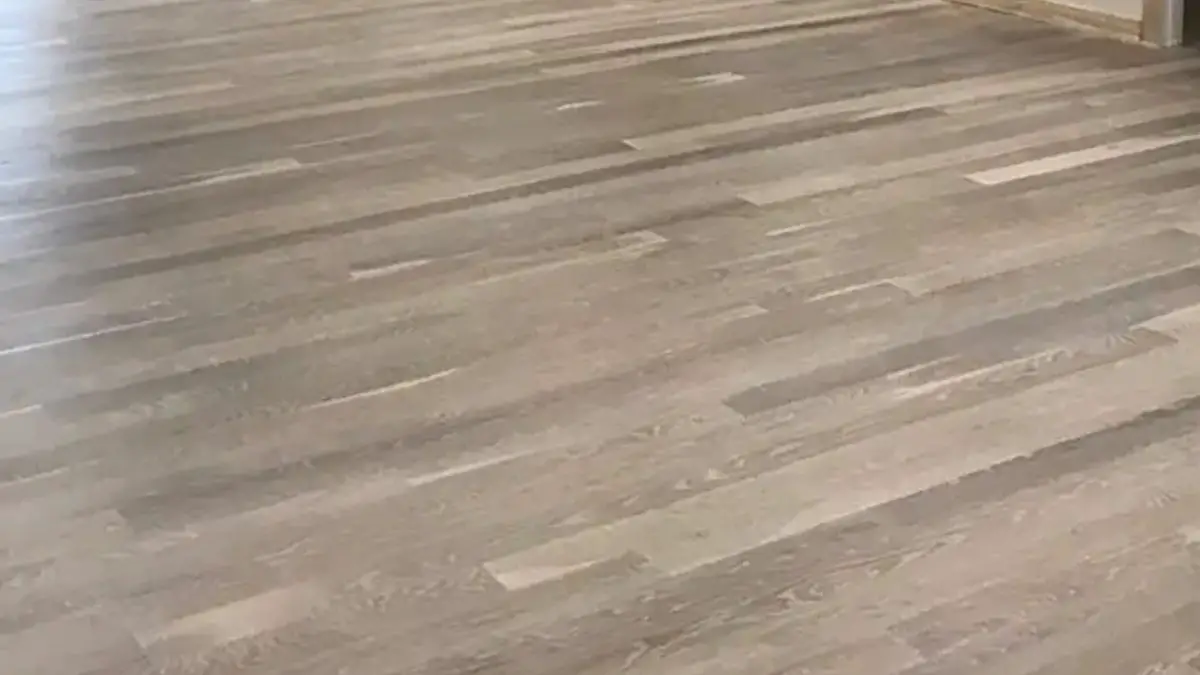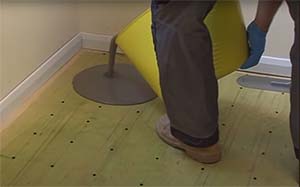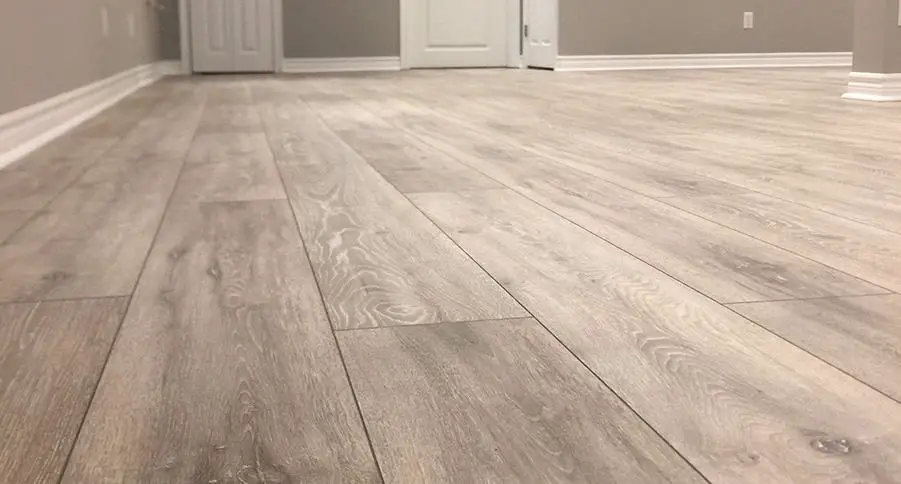
If you’re considering luxury vinyl tile (LVT) flooring for your home, you’ll first want to read up on the pros and cons. LVT flooring has been increasing in popularity in recent years, and for a good reason – it has a lot to offer! But there are some things you should know before making a decision.
LVT flooring stands for luxury vinyl tile flooring. It’s a vinyl product that gives off a natural stone or ceramic tile appearance but offers benefits that tile doesn’t. LVT flooring is a multi-layer vinyl product that is durable and suitable for high-traffic areas. It has a multi-ply vinyl layer, design layer, and protective wear layer in various colors and sizes.
There is more than meets the eye when it comes to LVT floors. This article will discuss how luxury vinyl flooring is made and all the practicalities they provide. We will also look at the differences between vinyl tile flooring materials and ceramic tiles.
How is LVT Flooring Made?
Luxury vinyl flooring is a laminate flooring product that simulates the look of natural materials like wood, stone, or ceramic tile. It’s a great choice for heavy traffic areas.
Part of its appeal is the realistic photographic design layer and transparent top layer. The top protective wear layer protects the look and is scratch resistant.
The manufacturing process comes together in roughly four steps:
- Sampling large amounts of raw materials like polyvinyl chloride resin (PVC) and calcium carbonate.
- The next step on this journey would be the “calendering process,” Multiple heated rollers press the compound together into a continuous sheet. After experimenting and checking the sheet’s thickness and width, vinyl floors are measured precisely and accurately.
- Using techniques involving pressure and heat, the lamination stage bonds each layer to the next until they are all completely formed.
- The result is 4-6 layers that all contribute to a finished product, which include:
- Mil wear layer: This makes the flooring easy to clean and protects the plank from easily getting scratched. Mil layers are 6, 12, 20, and 28. A MIL layer of 6 and 12 works well in residential homes. A MIL layer of 20 or 28 is better for commercial settings with heavy foot traffic. You can use a 20 MIL layer in both homes and businesses.
- Print layer: Provides specific designs for the flooring—many design options to fit your design vision.
- Stability layer: For better resistance and recovery. The stability layer gives luxury vinyl floors their strength.
- Backing layer: Sound absorbing underlay with a textured grip. The backing absorbs sound, making LVT quiet even in high-traffic areas.
After the finished result, it is then inspected by heating the product, including heating the product and applying the textured design that gives off a signature look. It is then reheated to remove excess stress between the layers and cool down. Then they are palletized and taken in for inspection.
They are taken to a specially made air-controlled room that regulates the same temperature year-round. This step is crucial because it keeps the product uniform during milling.
A controlled environment gives the technicians ample time to mark functional areas and inspect them before loading them onto presses. This offers consumers alternative sizes and gets them ready for sale.
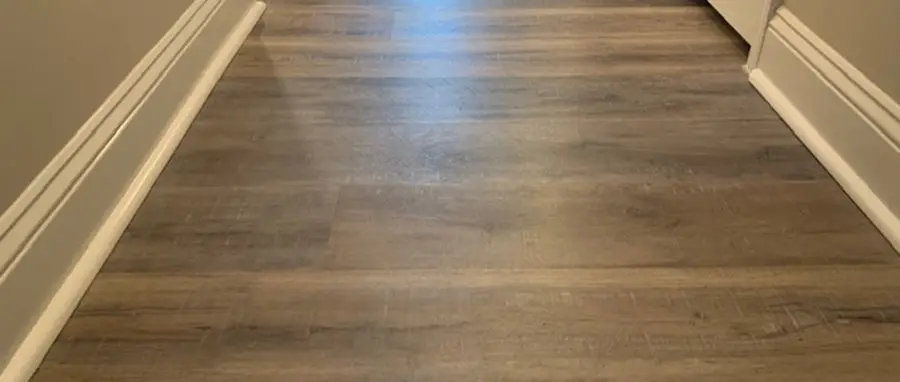
Why is LVT Popular?
The luxury vinyl tile is a high-quality product made in the 1970s to implement the realistic look of tile and hardwood. You can cut luxury vinyl into long pieces known as luxury vinyl plank flooring (LVP) or square and rectangular pieces for luxury vinyl tile (LVT).
One of the most significant differences between having a natural vs. vinyl floor is that luxury vinyl is much less expensive than natural materials. Many homeowners love how affordable LVT flooring is.
LVP mimics the look of hardwood flooring, whereas LVT mimics the look of ceramic or stone floors.
Not only this, but if you have a large family, it is one of the best options to get around your home, because many times, children and animals tend to scratch real wood floors, which leads to a lot of unwanted marks.
LVT flooring does not require much maintenance, whereas other floors must be waxed and polished often to continue looking new. It requires routine sweeping or a damp mop to clean up daily messes.
Does LVT Look Cheap?
If you are renovating a home and are on a budget, one of the first things to look at is any flooring price. You soon realize that real wood and stone can add up very fast, and it may not necessarily be something you can afford right now.
LVT floors cost $2 to $12 per square foot for materials. Professional installation cost is about $2 to $6 per square foot.
With that price tag, you may be unsure if LVT looks cheap or not.
Most people don’t feel that luxury vinyl tile looks cheap at all! They look so realistic that many professionals even mistake them for the real deal at first glance. Many interior designers prefer to use luxury vinyl flooring products because they are a budget-friendly choice in the design process.
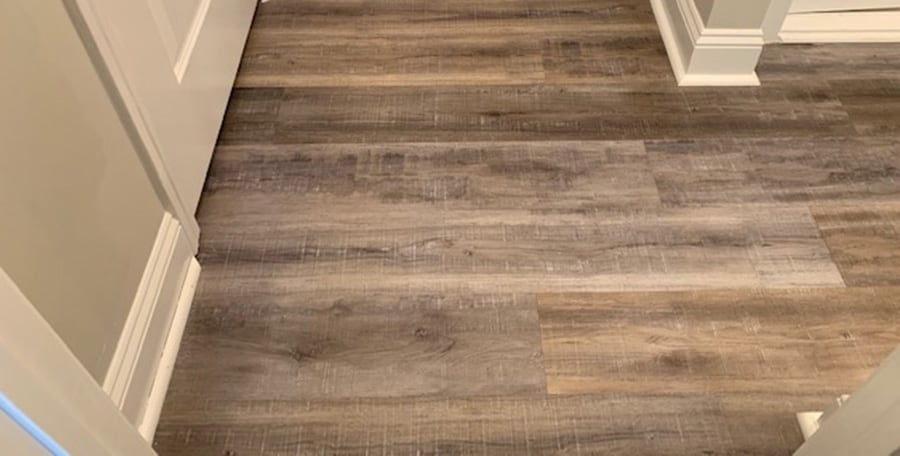
Pros of LVT Flooring:
Asking if luxury vinyl tile flooring is suitable is an excellent way to know if they will be worth investing in or if they will be a waste of money. I have these floors in my own home, and if I were to be brutally honest, these floors have a lot of beautiful qualities, which makes them an excellent addition to the house. LVT floors will not be very disappointing if you decide to go with them.
Overall, as long as you provide the best care possible for LVT floors, the lifespan will last long! Some of the essential qualities LVT floors possess are:
Waterproof Materials
LVT is a waterproof material making it difficult for mold to grow on them, although it can grow underneath. However, the water-resistant qualities make this flooring-type excellent. You clean up any spills once you realize it, as water can seep through the seams, especially if you opt to grout the joints for an authentic tile appearance.
Sound-Resistant
As mentioned above, the planks are built with an underlayment, causing the floors themselves to be quiet. Unlike laminate flooring that can make a clapping sound, the backing on luxury vinyl is quiet even in high-traffic areas.
Scratch-Resistant
The protective wear layer is a transparent top layer that resists scratching. The wear-resistant layer ranges from 6 MIL to 28 MIL and protects the photographic design that makes the tile beautiful. A thicker wear layer of 20 MIL is suitable for residential homes and businesses.
Comfortable
One of the best qualities is that LVT floors are incredibly comfortable. Although they are not carpet, they still feel softer on your feet, giving more pleasant feelings. If your subfloor is concrete, you may want to purchase an underlayment for better support, but it is not completely necessary.
Highly Durable
A single vinyl tile can hold up to 500 pounds alone, which makes the floors extremely durable and can withstand a lot of hard objects falling on the floor. While it is prone to dents and dings, it is more resistant to scratching than real wood flooring.
Stain-Resistant
With a quick clean-up, LVT floors look great. You do not need to mop the floors often unless you have a very active household. LVT can generally be cleaned by sweeping and a damp mop.
Easy to Install
Luxury vinyl tile is one of the easiest floors to install, thanks to its floating floor click-lock system. They are DIY friendly and don’t require special saws as you would need for stone or tile.
Cons of LVT Flooring
Like everything in life, some aspects of luxury vinyl tile we do not like. If the pros outweigh the cons, it will be best to continue purchasing them. Here are some reasons to not want LVT floors:
It Can be Tough to Remove
LVT doesn’t require adhesive, but if you decide to use adhesive, it is difficult to remove them. If you use strong glue and need to remove them, you can rent a power scraper for the day anywhere between $80 to $100 if you have difficulties getting it off. However, floating or click-lock planks are relatively easy to remove.
Inconsistent Quality
There are many brands of LVT, and each brand has varying thicknesses and wear-resistant layers. Vinyl tiles vary from 2mm to 8mm in thickness. Unfortunately, the thinner the size, the easier it is to ruin, so choose one that is thicker with a wear layer of 12 to 20 mil.
May Cause Health Issues
Most LVT floors are made from hard plastic, called VOCs, or volatile organic compounds. When first installed, the vinyl floor emits these gasses into the air, leading to air pollution and health issues, especially for people with respiratory problems. You should make sure the area is well-ventilated during installation.
Non-Biodegradable
LVT floors are tough to recycle, which can cause a massive issue for our green Earth later on. A few places can recycle vinyl flooring, but they are hard to come by. These centers should become more plentiful over time, but recycling options are limited.
This can mean that luxury vinyl and laminate flooring end up in landfills. These materials do not degrade, and many will discharge them when their beauty expires. Since you can’t repair the flooring, replacement is the only option. Without places to recycle them, they will end up in landfills.
Check to see if your region has a local area where you can drop the flooring off.
How Long Does LVT Flooring Last?
Given that luxury vinyl tile is taken care of in the proper fashion, the floors can last anywhere between 10 to 20 years.
But if the average vinyl flooring lasts 10 to 20 years old, what kind of precautions can you take to make these floors last as long as possible? Here are many tips and tricks to allow this process to happen to the best of your ability:
- Get a higher quality product: Some less expensive companies will make their floors less durable than advertised, so be careful where you choose the floors and find the best company. A little more money invested may cost you much less money.
- Sweep daily: This allows all crumbs and complex objects on the floor to leave, making it much easier to maintain. You will not be stepping on many small crumbs throughout the day, either!
- Mopping: Regular mopping ensures a better lifespan already. Do this 2 to 4 times a month with just regular dish soap and water, or another natural preference, like apple cider vinegar. If you decide to go with another cleaner, make sure to see if it is vinyl floor-friendly.
- Regularly check under furniture and the crevices: One of the main reasons LVT floors may get damaged is from a nail falling off of a piece of furniture or a sharp object that is unknown being in the corner. Check under your furniture and cracks to ensure this is not a significant issue.
- When moving: On floating floors, pick up furniture; the furniture may move a plank out of place if it is being scooted instead of picked up. Have an older member within your home help out if any furniture needs to be replaced or moved.
- Invest in blinds and curtains: UV rays have been known to fade LVT floors’ fine print. To avoid this issue, invest in blinds, move furniture, or put an area rug around areas where the sun hits the most. Make sure the mats have jute, cotton, and woven backings.
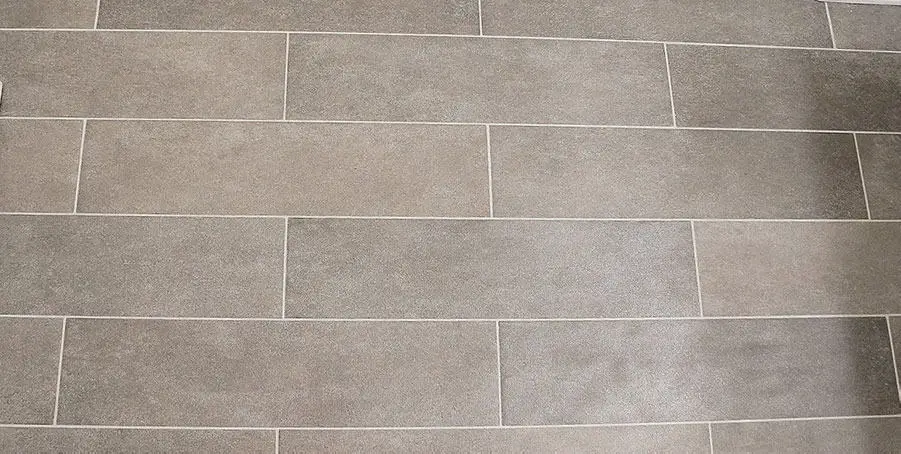
Is LVT Better than Ceramic Tile?
Given that tile has a much larger lifespan than LVT floors, it would be the best option long-term. But luxury vinyl tile has come a long way in terms of look, making it very hard to distinguish between the two, making everyone love them all the more.
Ceramic tile costs $1 to $25 per square foot. Although ceramic lasts between 75 to 100 years, the trends tend to fade quickly, leading many to replace tile sooner. Typically many will replace tile every 20 years if for no other reason than modernizing to current trends.
LVT can easily make a specific design and have upkeep on the trendiness, whereas if you wish to go with ceramic tile, you would need to go with something safe, like white or neutral tiling.
However, vinyl floors can not be customizable as you can create many designs with tile floors. Not only this, but tile tends to take much longer to install due to the extra steps required.
LVT’s excellent quality is much less likely to crack or break, and it is easier to take it out. With ceramic, it can more easily be broken and more challenging to remove, and you would need to be extremely careful if this were the case, as the tiny pieces can get under your skin, and you’ll most likely have to deal with it for the next few days after.
How Many Kinds of LVT Flooring are There?
It may be a hard choice since LVT has so many flooring options. Although floors may be trendy and you know the type of look you want in the home, these floors boil down to 2 different main types: loose lay and glue down. It would be best if you choose which option suits you more.
- Glue down vinyl floor: Best for families with animals and small children. The adhesive will better keep the tiles locked into place. The bond is applied to the subfloor first, and then the tiles go on top of them. However, if you choose to go this route, know that it is hard to remove.
- Self-adhesive planks and tile: These are great for a quick and easy installation. You need to remove the protective layer of film, put them into the desired position, and press it down. The self-adhesive installation is also very forgiving in fixing mistakes and removal. You can remove by heating them with a heat gun or blow dryer and cutting them into smaller pieces for easy removal.
- Loose lay: It is very similar in style to the self-adhesive but with even more slack in installation because they use high friction-based unique bottom layers. Because of that, they get a solid grip on the subflooring. Despite that, they are still easy to remove using the same cut and pull method as the self-adhesive, but you won’t need to heat them. One final perk about the loose lay method would be that there is no leftover residue, which makes cleaning up before or after jobs easier.
- Interlocking: Utilize unique grooves and tongues along the edges of the planks and tiles that allow them to snap into place. These kinds of planks and tiles use the click-lock flooring system most of us know and love. Note that if you want to replace a single portion of these planks or tiles, the entire row will need to come up.
What’s the Difference Between LVT and LVP?
The most significant difference that you can find between the two would primarily be the sizing options and their general desired aesthetic. LVT typically imitates natural stone-based designs, while LVP aims to replicate hardwood texture and looks. LVT is also more often found in kitchens and bathrooms, whereas LVP appears more often in living rooms or bedrooms.
Frequently Asked Questions
Is LVT Flooring Any Good?
LVT is a high-quality vinyl flooring often preferred over carpet, hardwood, or tile for its affordability, low maintenance, and durability. LVT is a popular choice among active families because the flooring is kid and pet friendly.
Does LVT Increase Home Value?
Luxury vinyl tile is a great material to add value to rental homes, kitchens, bathrooms, and laundry rooms because of its long-term durability and water resistance. However, LVT does not have the market home value of real hardwood, stone, or tile.
If you’re looking to spruce up a house to sell, luxury vinyl products can increase home value where dated or damaged flooring exists, like worn or stained carpeting and sheet vinyl.
Is LVT Better Than Engineered Wood?
Both engineered wood and LVT are suitable for concrete substrates. In high-moisture locations (such as bathrooms, laundry rooms, and kitchens), LVT is superior to engineered wood flooring because it is water-resistant against humidity, spills, and mopping. LVT is considerably less expensive to produce and install than engineered wood.
Is LVT Good for Kitchens?
Kitchen flooring options include high-end vinyl tile (LVT) and vinyl roll (also known as sheet vinyl), suitable for kitchens. They’re moisture resistant, durable, and simple to maintain. Luxury vinyl products are scratch and water-resistant, withstanding heavy traffic and routine spills from cooking or cleaning up in the kitchen.
Is LVT OK in Bathrooms?
A luxury vinyl tile (LVT) is OK on bathroom floors. LVT is waterproof against humidity, spills, and mopping. I would not recommend using LVT on bathtub or shower surrounds as water can seep behind the tile in unsealed corners causing mold to grow behind the LVT.
Can You Use Luxury Vinyl Tiles on Walls?
Luxury vinyl tile is a flooring product, but you can use it on walls. You’ll need to use an adhesive to secure the wall if you intend to use LVT on bathtub or shower walls. LVT is waterproof against spills and mopping but is not from prolonged water exposure to shower walls. Water can seep behind the LVT and cause mold to grow.
Some manufacturers claim their LVT is suitable for tub and shower surrounds, but they require expert installation methods, which many contractors may not know.
Final Thought
In conclusion, LVT flooring gives off the appearance of looking like tile but is not the real deal. Vinyl floors are much more affordable and give your home the same look, which most people cannot tell the difference just by looking upfront. All in all, they will make an excellent addition to your home or rental property!




